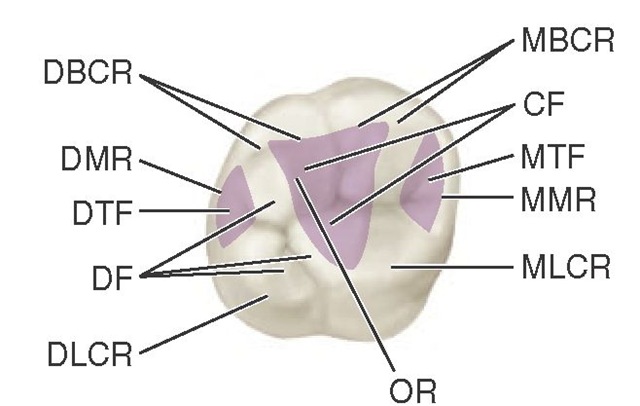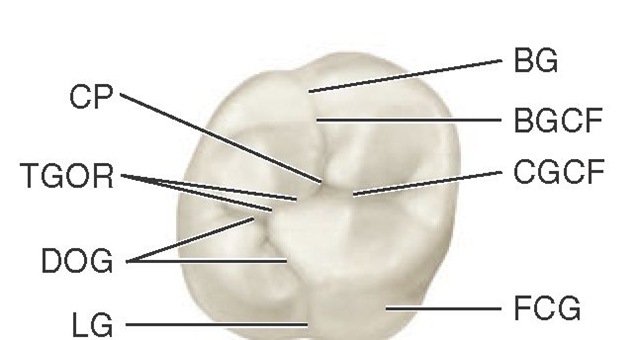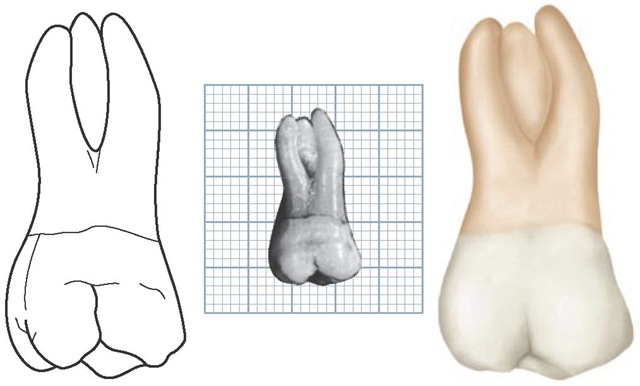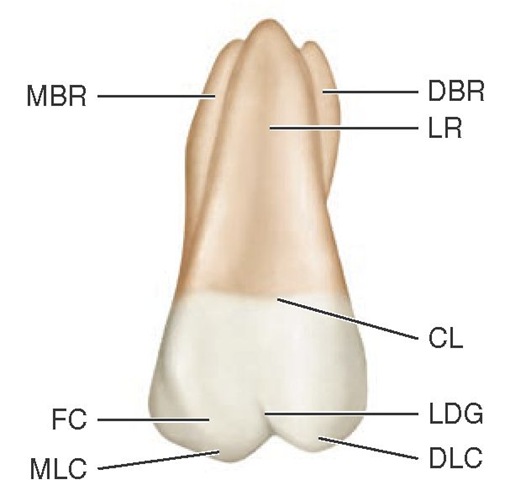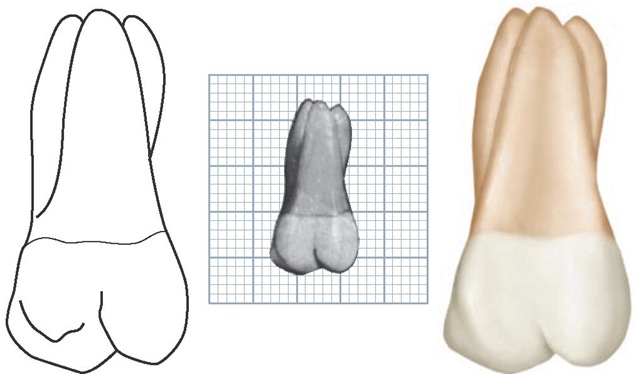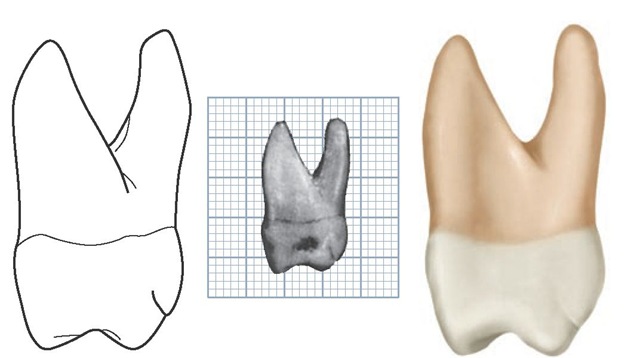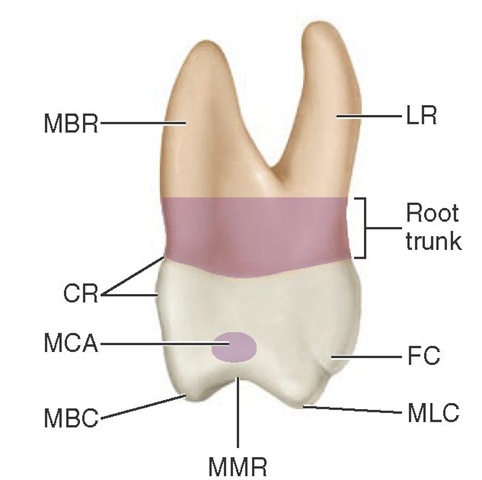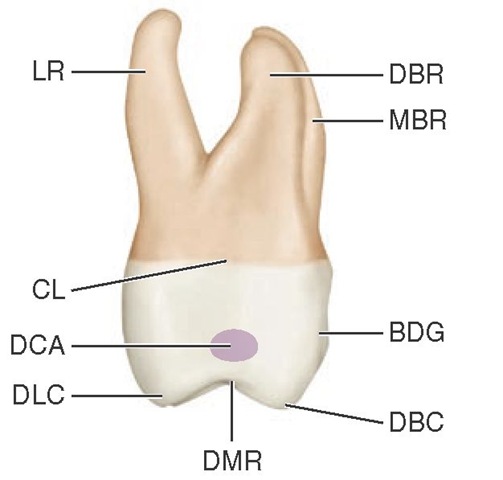The maxillary molars differ in design from any of the teeth previously described. These teeth assist the mandibular molars in performing the major portion of the work in the mastication and comminution of food. They are the largest and strongest maxillary teeth, by virtue both of their bulk and of their anchorage in the jaws. Although the crowns on the molars may be somewhat shorter than those on the premolars, their dimensions are greater in every respect. The root portion may be no longer than that of the premo-lars, but instead of one root or a bifurcated root, the maxillary molar root is broader at the base in all directions and is trifurcated into three well-developed prongs that are actually three full-size roots emanating from a common broad base above the crown.
Generally speaking, the maxillary molars have large crowns with four well-formed cusps. They have three roots, two buccal and one lingual. The lingual root is the largest. The crowns have two buccal cusps and two lingual cusps. The outlines and curvatures of all the maxillary molars are similar. Developmental variations will be set forth under descriptions of the separate molars.
Before a detailed description of the maxillary first molar is begun, some statements will be made that are applicable to all first molars, mandibular and maxillary.
The permanent first molars usually appear in the oral cavity when the child is 6 years old. The mandibular molars precede the maxillary molars. The first permanent molar (maxillary or mandibular) erupts posterior to the second deciduous molar, taking up a position in contact with it. Therefore the first molar is not a succedaneous tooth because it has no predecessor. The deciduous teeth are all still in position and functioning when the first molar takes its place.
Because the development of the bones of the face is downward and forward, sufficient space has been created normally at the age of 6 for the accommodation of this tooth.
The normal location of the first permanent molar is at the center of the fully developed adult jaw anteroposteri-orly. As a consequence of the significance of their positions and the circumstances surrounding their eruption, the first molars may also be considered cornerstones of the dental arches. A full realization of the significance of these teeth as units in the arches and their function and positions relative to the other teeth will be gained when an opportunity comes to study the arrangement of the teeth with their occlusion and the temporomandibular articulation of the jaws. Subsequent topics cover those phases.
Maxillary First Molar
Figures 11-1 through 11-18 illustrate the maxillary first molar from all aspects. The crown of this tooth is wider buccolingually than mesiodistally. Usually the extra dimension buccolingually is about 1 mm (Table 11-1). This, however, varies in individuals (see Figure 11-17, 1, 5, 7, and 9). From the occlusal aspect, the inequality of the measurements in the two directions appears slight. Although the crown is relatively short, it is broad both mesiodistally and buccolingually, which gives the occlusal surface its generous dimensions.
The maxillary first molar is normally the largest tooth in the maxillary arch. It has four well-developed functioning cusps and one supplemental cusp of little practical use. The four large cusps of most physiological significance are the mesiobuccal, the distobuccal, the mesiolingual, and the distolingual.
Table 11-1 Maxillary First Molar
|
First evidence of calcification |
|
At birth |
|||||
|
Enamel completed |
3-4 yr |
||||||
|
Eruption |
6 yr |
||||||
|
Root completed |
9-10 yr |
||||||
|
Measurement Table |
|||||||
|
|
CERvico-occlusal Length of Crown |
Length of Root |
Mesiodistal Mesiodistal Diameter Diameter of Crown of Crown at Cervix |
Labio- or Buccolingual Diameter of Crown |
Labio- or Buccolingual Diameter of Crown at Cervix |
Curvature of Cervical Line—Mesial |
Curvature of Cervical Line—Distal |
|
Dimensions* suggested for carving technique |
7.5 |
Buccal = 12 Lingual = 13 |
10.0 8.0 |
11.0 |
10.0 |
1.0 |
0.0 |
Figure 11-1 Maxillary right first molar, occlusal aspect. MBCR, Mesiobuccal cusp ridge; CF, central fossa (shaded area); MTF, mesial triangular fossa (shaded area); MMR, mesial marginal ridge; MLCR, mesiolingual cusp ridge; OR, oblique ridge; DLCR, distolingual cusp ridge; DF, distal fossa; DTF, distal triangular fossa (shaded area); DMR, distal marginal ridge; DBCR, distobuccal cusp ridge.
Figure 11-2 Maxillary right first molar, occlusal aspect, developmental grooves. BG, Buccal groove; BGCF, buccal groove of central fossa; CGCF, central groove of central fossa; FCG, fifth cusp groove; LG, lingual groove; DOG, distal oblique groove; TGOR, transverse groove of oblique ridge; CP, central pit.
A supplemental cusp is called the cusp or tubercle of Carabelli. This morphological trait can take the form of a well-developed fifth cusp, or it can grade down to a series of grooves, depressions, or pits on the mesial portion of the lingual surface. This trait has been used to distinguish populations.
Figure 11-3 Maxillary right first molar, buccal aspect. LR, Lingual root; MBR, mesiobuccal root; BDG, buccal developmental groove; MBC, mesiobuccal cusp; MLC, mesiolingual cusp; DBC, distobuccal cusp; CL, cervical line; DBR, distobuccal root.
This supplemental cusp is found lingual to the mesiolin-gual cusp, which is the largest of the well-developed cusps. Usually, a developmental groove is found, leaving a record of cusp development, unless it has been erased by frictional wear. The fifth cusp or a developmental trace at its usual site serves to identify the maxillary first molar. A specimen of this tooth showing no trace of its typical characteristic would be rare.
The three roots of generous proportions are the mesiobuc-cal, distobuccal, and lingual. These roots are well separated and well developed, and their placement gives this tooth maximum anchorage against forces that would tend to unseat it. The roots have their greatest spread parallel to the line of greatest force brought to bear against the crown diagonally in a buccolingual direction. The lingual root is the longest root. It is tapered and smoothly rounded. The mesiobuccal root is not as long, but it is broader buccolin-gually and shaped (in cross section) so that its resistance to torsion is greater than that of the lingual root. The distobuc-cal root is the smallest of the three and smoothly rounded.
The development of maxillary first molars rarely deviates from the accepted normal. Ten specimens with uncommon variations are shown in Figure 11-18.
DETAILED DESCRIPTION OF THE MAXILLARY FIRST MOLAR FROM ALL ASPECTS
Buccal Aspect
The crown is roughly trapezoidal, with cervical and occlusal outlines representing the uneven sides (see Figures 11-4, 11-13, 11-14, and 11-15). The cervical line is the shorter of the uneven sides (see Figure 4-16, D).
When the buccal aspect of this tooth is viewed with the line of vision at right angles to the buccal developmental groove of the crown, the distal side of the crown can be seen in perspective, which is possible because of the obtuse character of the distobuccal line angle.Parts of four cusps are seen, the mesiobuc-cal, distobuccal, mesiolingual, and distolingual.
The mesiobuccal cusp is broader than the distobuccal cusp, and its mesial slope meets its distal slope at an obtuse angle. The mesial slope of the distobuccal cusp meets its distal slope at approximately a right angle. The distobuccal cusp is therefore sharper than the mesiobuccal cusp, and it is at least as long and often longer (see Figure 11-15, 4, 6, 7, 8, and 9).
Figure 11-4 Maxillary right first molar, buccal aspect. (Grid = 1 sq mm.)
Figure 11-5 Maxillary right first molar, lingual aspect. DBR, Distobuccal root; LR, lingual root; CL, cervical line; LDG, lingual developmental groove; DLC, distolingual cusp; MLC, mesiolingual cusp; FC, fifth cusp; MBR, mesiobuccal root.
The buccal developmental groove that divides the two buccal cusps is approximately equidistant between the mesiobuccal and distolingual line angles. The groove slants occlusoapically in a line of direction parallel to the long axis of the distobuccal root. It terminates at a point approximately half the distance from its origin occlusally to the cervical line of the crown. Although the groove is not deep at any point, it becomes more shallow toward its termination, gradually fading out. Lateral to its terminus is a dip in the enamel of the crown that is developmental in character and extends for some distance mesially and distally.
Figure 11-6 Maxillary right first molar, lingual aspect. (Grid = 1 sq mm.)
Figure 11-7 Maxillary right first molar, mesial aspect. (Grid = 1 sq mm.)
Figure 11-8 Maxillary right first molar, mesial aspect. LR, Lingual root; FC, fifth cusp; MLC, mesiolingual cusp; MMR, mesial marginal ridge; MBC, mesiobuccal ridge; MCA, mesial contact area; CR, cervical ridge; MBR, mesiobuccal root.
Figure 11-9 Maxillary right first molar, distal aspect. DBR, Distobuccal root; MBR, mesiobuccal root; BDG, buccal developmental groove; DBC, distobuccal cusp; DMR, distal marginal ridge; DLC, distolingual cusp; DCA, distal contact area; CL, cervical line; LR, lingual root.
The cervical line of the crown does not have much curvature from mesial to distal; however, it is not as smooth and regular as that found on some of the other teeth. The line is generally convex with the convexity toward the roots.
The mesial outline of the crown from this aspect follows a nearly straight path downward and mesially, curving occlusally as it reaches the crest of contour of the mesial surface, which is the contact area. This crest is approximately two thirds the distance from cervical line to tip of mesiobuccal cusp. The mesial outline continues downward and distally and becomes congruent with the outline of the mesial slope of the mesiobuccal cusp.
The distal outline of the crown is convex; the distal surface is spheroidal. The crest of curvature on the distal side of the crown is located at a level approximately half the distance from cervical line to tip of cusp. The distal contact area is in the middle of the middle third.
Often from this aspect, a flattened area or a concave area is seen on the distal surface immediately above the distobuc-cal cusp at the cervical third of the crown.
All three of the roots may be seen from the buccal aspect. The axes of the roots are inclined distally. The roots are not straight, although the buccal roots show an inclination to curvature halfway between the point of bifurcation and the apices. The mesiobuccal root curves distally, starting at the middle third. Its axis usually is at right angles to the cervical line. The distal root is straighter, with its long axis at an acute angle distally with the cervical line. It has a tendency toward curvature mesially at its middle third.
The point of bifurcation of the two buccal roots is located approximately 4 mm above the cervical line. This measurement varies somewhat, of course. Nevertheless, the point is much farther removed from the cervical line than in the deciduous molars. This relation is typical when all permanent molars are compared with all deciduous molars.
A deep developmental groove buccally on the root trunk of the maxillary first molar, which starts at the bifurcation and progresses downward, becoming more shallow until it terminates in a shallow depression at the cervical line. Sometimes this depression extends slightly onto the enamel at the cervix.
The reader must keep in mind the fact that molar roots originate as a single root on the base of the crown. They then are divided into three roots, as in the maxillary molars, or two roots, as in the mandibular molars. The common root base is called the root trunk (see Figures 11-3 and 11-8).
In judging the length of the roots and the direction of their axes, we must indicate the part of the root trunk that is congruent with each root as part of it, because they [i.e., the root trunk and the root] function as an entity. Usually, the lingual root is the longest, and the two buccal roots are approximately equal in length. Considerable variance is evident, although the difference is a matter of a millimeter or so only in the average first molars with normal development.
From the buccal aspect, a measurement of the roots inclusively at their greatest extremities mesiodistally is less than a calibration of the diameter of the crown mesiodistally.
No invariable rule covers the relative length of crown and root when the upper first molar is described. On the average, the roots are about twice as long as the crown.
